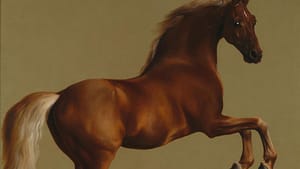Stay in the Loop
BSR publishes on a weekly schedule, with an email newsletter every Wednesday and Thursday morning. There’s no paywall, and subscribing is always free.
An appreciation of George Stubbs

There's no lack of works by George Stubbs (1724-1806), the gifted 18th-century English animal and sporting painter, in museums around the world, particularly those in the United States and in Great Britain. In London and elsewhere, we see Stubbs as he almost single-handedly launched the figurative animal genre, in portraits and in landscapes that burst with the kind of real-life energy that invested many of the greenswards of country homes and stables shaped by Capability Brown's capable hand.
Aristocratic horsemen and their grooms and jockeys often populate these scenes, but it's always the horse we care about most. Even in paintings in which horses don't figure, the setting is always sufficiently pastoral that, at any given moment, the viewer almost expects a foal or two to trot onto the canvas. Stubbs's marvelous dog pictures can stand alone, but they also summon up a country life wherein a mounted gentleman would never be out of place.
To completely understand Stubbs, then, requires focusing on Stubbs’s best work, as an equine genre painter. Be it in the stable yard, at the track, or on the hunt course, Stubbs's greatness is seen in those paintings, in which he pioneered realism, undergirding the skins of his animal subjects with anatomical accuracy. (How? For one thing, he actually dissected horses to discover their inner makeup.) In Stubbs’s world of realism, horses no longer looked like the stick figures of previous centuries, or the “primitive” representations that American Indians were then painting on buffalo hides in the New World. Stubbs’s horses moved their legs with an accuracy that was confirmed only later when photography came into its own a century on.
One might disagree about which painting best represents Stubbs at his peak.
 No lovable poodles
No lovable poodles
We can disregard his lovable poodles. Hounds, cows, leopards can also be set aside. Is it, then, Horse Attacked by a Lion (1762), an imagined scene that evokes a horse's combative strength and weakness to predatory fate? Maybe even Hambletonian, Rubbing Down (1800), with its zoom-like graphic power?
Actually, to my mind, the answer is in the National Gallery in London.
The work is called Whistlejacket, painted in the artist's 38th year. Many great years of great paintings lay ahead. But for a moment in 1762, the year that Whistlejacket was created, some of Stubbs’s most visionary and creative influences and skills merged into a single image, on a monumental canvas (almost ten feet square) of the Second Marquess of Rockingham's prized Arabian stallion.
The best way to approach the picture is via the Gallery's Sainsbury wing on the west side of Trafalgar Square. Proceeding up the grand stairway, you turn right to travel through two or three galleries of Renaissance pictures, and, then, framed by an approaching gallery's doorway, you encounter the imposing full-frontal view of Whistlejacket, in all its power and glory. Nicknamed “a horse as large as life,” Whistlejacket is Stubbs’s only life-sized painting. It's also clearly his masterpiece.
Venturing into the modern
Given that there is no background, the portrait is all horse. In fact, some critics used to posit that the picture was unfinished — but then it became evident that Stubbs was actually breaking away from the constraints of 18th-century academic painting: venturing, even, with Rockingham's consent, into the modern.
How that came about was collaborative. And due, interestingly enough as well, to Rockingham's passion for collecting sculpture, an appreciation that arose during his Grand Tour of Italy.
 Well before Whistlejacket, Stubbs had started doing away with backgrounds, most notably in the aptly named Mares and Foals Without a Background (1762). The idea was to create a string of horses as if patterned into a frieze. Whistlejacket was modeled as sculpture on canvas.
Well before Whistlejacket, Stubbs had started doing away with backgrounds, most notably in the aptly named Mares and Foals Without a Background (1762). The idea was to create a string of horses as if patterned into a frieze. Whistlejacket was modeled as sculpture on canvas.
For an Arabian, Whistlejacket is big, well over 5 hands and racehorse size. He's no bombproof gelding. One wonders whether he's about to bolt? His stance suggests yes. His glinting right eye, directed at the viewer, is equally uninviting. Beware! He rears — soars? — on his hindquarters. As in real life, the viewer might feel it prudent to step back and stand clear. You can almost hear the snort and whinny.
Whistlejacket in fact had a thing or two to say about that realism. While Stubbs was painting the life portrait, the story goes, he took a break and placed the almost-finished canvas against a stable wall. Whistlejacket inadvertently caught a glimpse of the work and was so taken by the belief that he was confronting a raging stallion that he began “to stare and look wildly at the picture, endeavouring to get at it, to fight and kick it.”
Sign up for our newsletter
All of the week's new articles, all in one place. Sign up for the free weekly BSR newsletters, and don't miss a conversation.

 Richard Carreño
Richard Carreño